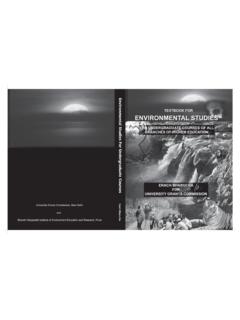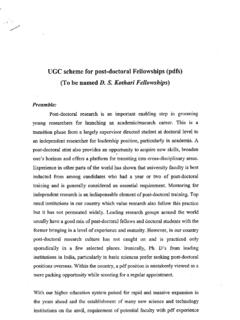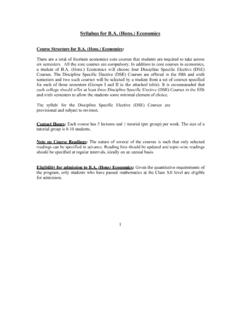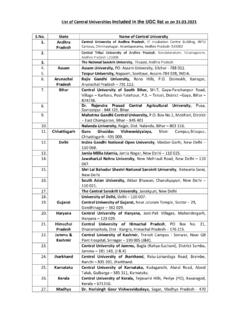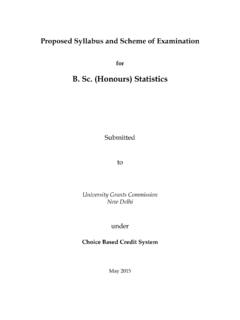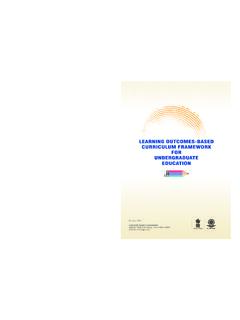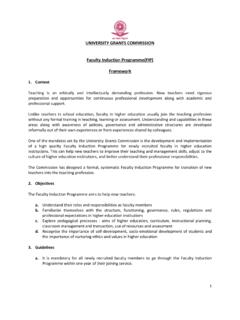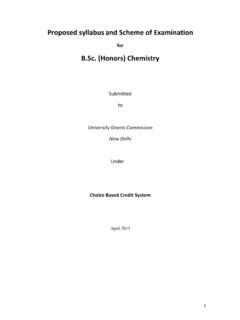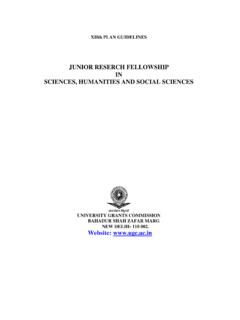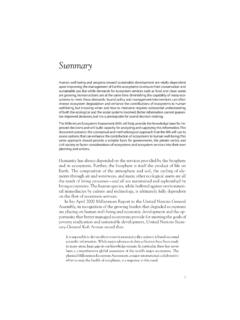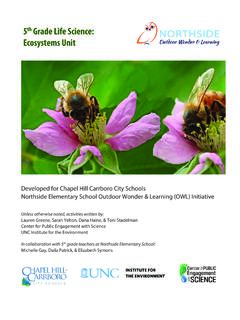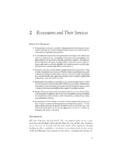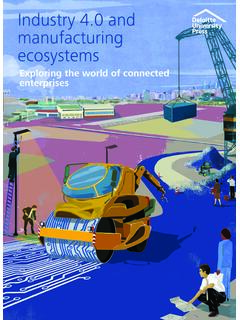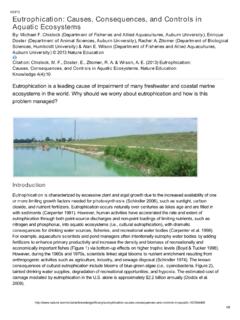Transcription of UNIT 3: Ecosystems - UGC
1 53 EcosystemsUNIT 3 OF AN ECOSYSTEMCONCEPT OF AN ECOSYSTEMCONCEPT OF AN ECOSYSTEMCONCEPT OF AN ECOSYSTEMCONCEPT OF AN Understanding Ecosystem Resource STRUCTURE AND FUNCTIONS OF AN ECOSYSTEMSTRUCTURE AND FUNCTIONS OF AN ECOSYSTEMSTRUCTURE AND FUNCTIONS OF AN ECOSYSTEMSTRUCTURE AND FUNCTIONS OF AN ECOSYSTEMSTRUCTURE AND FUNCTIONS OF AN PRODUCERS, CONSUMERS AND DECOMPOSERSPRODUCERS, CONSUMERS AND DECOMPOSERSPRODUCERS, CONSUMERS AND DECOMPOSERSPRODUCERS, CONSUMERS AND DECOMPOSERSPRODUCERS, CONSUMERS AND ENERGY FLOW IN THE ECOSYSTEMENERGY FLOW IN THE ECOSYSTEMENERGY FLOW IN THE ECOSYSTEMENERGY FLOW IN THE ECOSYSTEMENERGY FLOW IN THE The water The Carbon The Oxygen The Nitrogen The energy Integration of cycles in SUCCESSIONECOLOGICAL SUCCESSIONECOLOGICAL SUCCESSIONECOLOGICAL SUCCESSIONECOLOGICAL CHAINS, FOOD WEBS AND ECOLOGICAL PYRAMIDSFOOD CHAINS, FOOD WEBS AND ECOLOGICAL PYRAMIDSFOOD CHAINS, FOOD WEBS AND ECOLOGICAL PYRAMIDSFOOD CHAINS, FOOD WEBS AND ECOLOGICAL PYRAMIDSFOOD CHAINS, FOOD WEBS AND ECOLOGICAL The food The food The ecological , TYPES, CHARACTERISTIC FEATURES, STRUCTURE AND FUNCTIONSINTRODUCTION, TYPES, CHARACTERISTIC FEATURES.
2 STRUCTURE AND FUNCTIONSINTRODUCTION, TYPES, CHARACTERISTIC FEATURES, STRUCTURE AND FUNCTIONSINTRODUCTION, TYPES, CHARACTERISTIC FEATURES, STRUCTURE AND FUNCTIONSINTRODUCTION, TYPES, CHARACTERISTIC FEATURES, STRUCTURE AND Forest Grassland Desert Aquatic Ecosystems (ponds, lakes, streams, rivers, estuaries, oceans) , 5:08 PM5354 Environmental Studies for Undergraduate CONCEPT OF AN CONCEPT OF AN CONCEPT OF AN CONCEPT OF AN CONCEPT OF AN ECOSYSTEMAn Ecosystem is a region with a specific andrecognizable landscape form such as forest,grassland, desert, wetland or coastal area. Thenature of the ecosystem is based on its geo-graphical features such as hills, mountains,plains, rivers, lakes, coastal areas or islands.
3 It isalso controlled by climatic conditions such as theamount of sunlight, the temperature and therainfall in the region. The geographical, climaticand soil characteristics form its non-living (abi-otic) component. These features create condi-tions that support a community of plants andanimals that evolution has produced to live inthese specific conditions. The living part of theecosystem is referred to as its biotic are divided into terrestrial or land-based Ecosystems , and aquatic Ecosystems inwater. These form the two major habitat condi-tions for the Earth s living the living organisms in an area live in com-munities of plants and animals. They interactwith their non-living environment, and with eachother at different points in time for a large num-ber of reasons.
4 Life can exist only in a small pro-portion of the earth s land, water and its atmo-sphere. At a global level the thin skin of the earthon the land, the sea and the air, forms the a sub-global level, this is divided into bio-bio-bio-bio-bio-geographical realms, geographical realms, geographical realms, geographical realms, geographical realms, eg. Eurasia called thepalaeartic realm; South and South-East Asia (ofwhich India forms a major part) is the Orientalrealm; North America is the Nearctic realm;South America forms the Neotropical realm;Africa the Ethiopian realm; and Australia theAustralian a national or state level, this forms biogeo-biogeo-biogeo-biogeo-biogeo-graph ic regions.
5 Graphic regions. graphic regions. graphic regions. graphic regions. There are several distinctivegeographical regions in India- the Himalayas, theGangetic Plains, the Highlands of Central India,the Western and Eastern Ghats, the semi-ariddesert in the West, the Deccan Plateau, theCoastal Belts, and the Andaman and NicobarIslands. These geographically distinctive areashave plants and animals that have been adaptedto live in each of these an even more local level, each area has sev-eral structurally and functionally identifiable eco-eco-eco-eco-eco-systemssystemssystem ssystemssystems such as different types of forests, grass-lands, river catchments, mangrove swamps indeltas, seashores, islands, etc.
6 To give only a fewexamples. Here too each of these forms a habi-tat for specific plants and have been formed on land and inthe sea by evolution that has created species tolive together in a specific region. Thus ecosys -tems have both non-living and living compo-nents that are typical to an area giving it its ownspecial characteristics that are easily :Definition:Definition:Definition:Defini tion: The living community of plants andanimals in any area together with the non-liv-ing components of the environment such as soil,air and water, constitute the Ecosystems are fairly robust and are lessaffected by a certain level of human are highly fragile and are quickly de-stroyed by human activities.
7 Mountain ecosys -tems are extremely fragile as degradation offorest cover leads to severe erosion of soil andchanges in river courses. Island Ecosystems areeasily affected by any form of human activitywhich can lead to the rapid extinction of sev-eral of their unique species of plants and ani-mals. Evergreen forests and coral reefs are alsoexamples of species rich fragile ecosystemswhich must be protected against a variety ofhuman activities that lead to their and wetland Ecosystems can be seriouslyaffected by pollution and changes in surround-ing , 5:08 Understanding Understanding Understanding Understanding Understanding ecosystemsNatural Ecosystems include the forests, grass-lands, deserts, and aquatic Ecosystems such asponds, rivers, lakes, and the sea.
8 Man modifiedecosystems include agricultural land and urbanor industrial land use ecosystem has a set of common featuresthat can be observed in the field: What does the ecosystem look like? One should be able to describe specific fea-tures of the different Ecosystems in onesown surroundings. Field observations mustbe made in both urban and natural sur-roundings. What is its structure?Is it a forest, a grassland, a water body, anagricultural area, a grazing area, an urbanarea, an industrial area, you should see are its different char-acteristics. A forest has layers from theground to the canopy. A pond has differ-ent types of vegetation from the peripheryto its center.
9 The vegetation on a mountainchanges from its base to its summit. What is the composition of its plant andanimal species?List the well-known plants and animals youcan see. Document their abundance andnumbers in nature: very common, common,uncommon, rare. Wild mammals will notbe seen in large numbers, cattle would becommon. Some birds are common whichare the most common species? Insect spe-cies are very common and most fact there are so many that they cannotbe easily counted. How does the ecosystem work ?The ecosystem functions through severalbiogeochemical cycles and energy transfermechanisms. Observe and document thecomponents of the ecosystem which con-sists of its non-living or abiotic features suchas air, water, climate and soil.
10 Its biotic com-ponents, the various plants and these aspects of the ecosystem inter-act with each other through several func-tional aspects to form Nature s , herbivores and carnivores can beseen to form food chains. All these chainsare joined together to form a web of life on which man depends. Each of these useenergy that comes from the sun and pow-ers the Ecosystem Ecosystem Ecosystem Ecosystem Ecosystem degradationEcosystems are the basis of life itself! The natu-ral Ecosystems in the wilderness provide a vari-ety of products and are regions in which a num-ber of vital ecological processes are present,without which human civilization would not beable to are however frequently disrupted byhuman actions which lead to the extinction ofspecies of plants and animals that can live onlyin the different natural Ecosystems .
